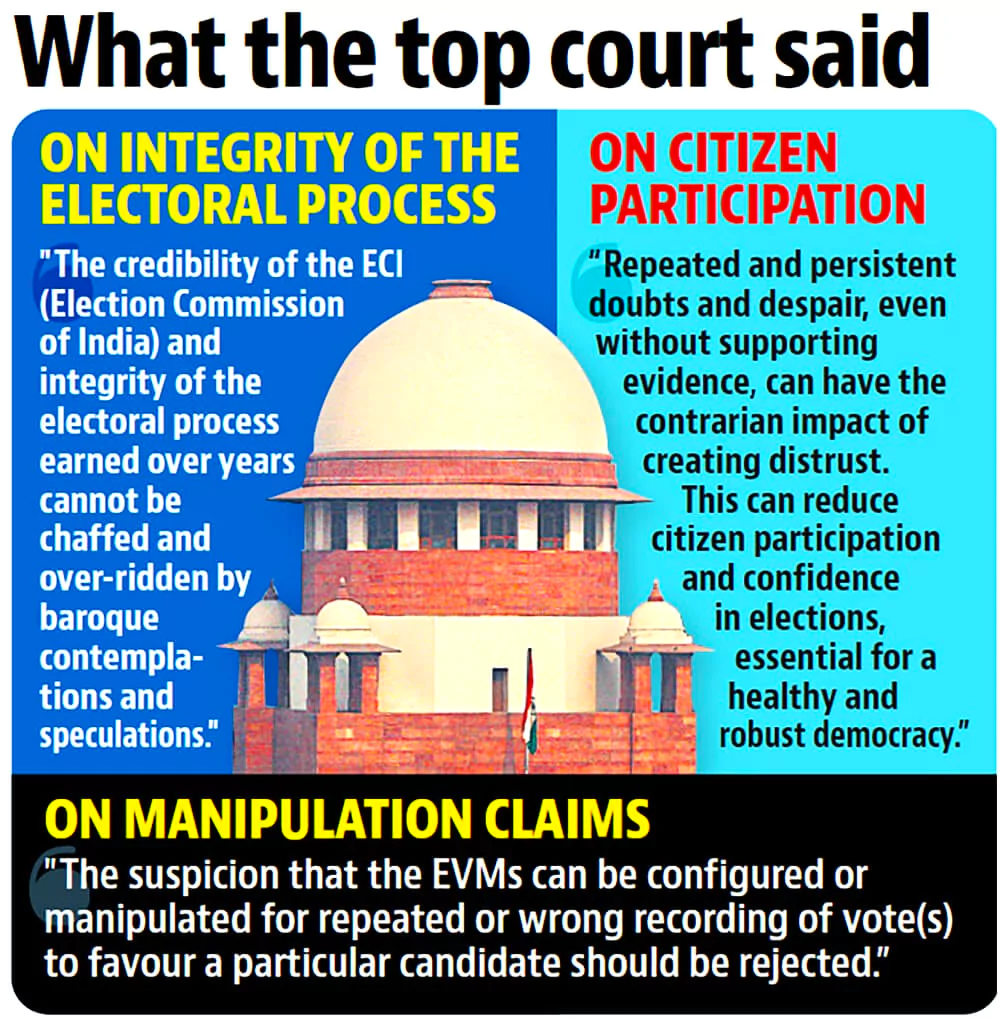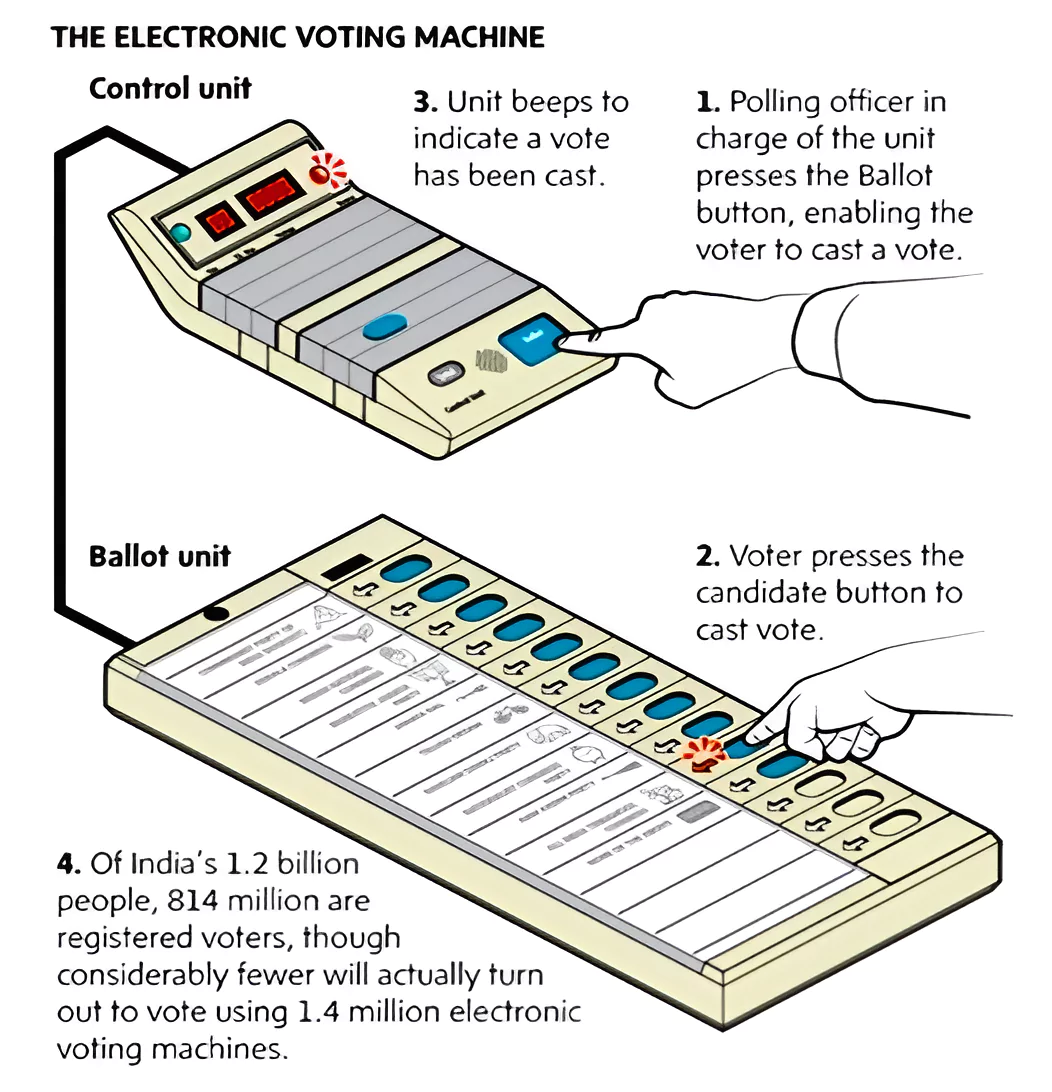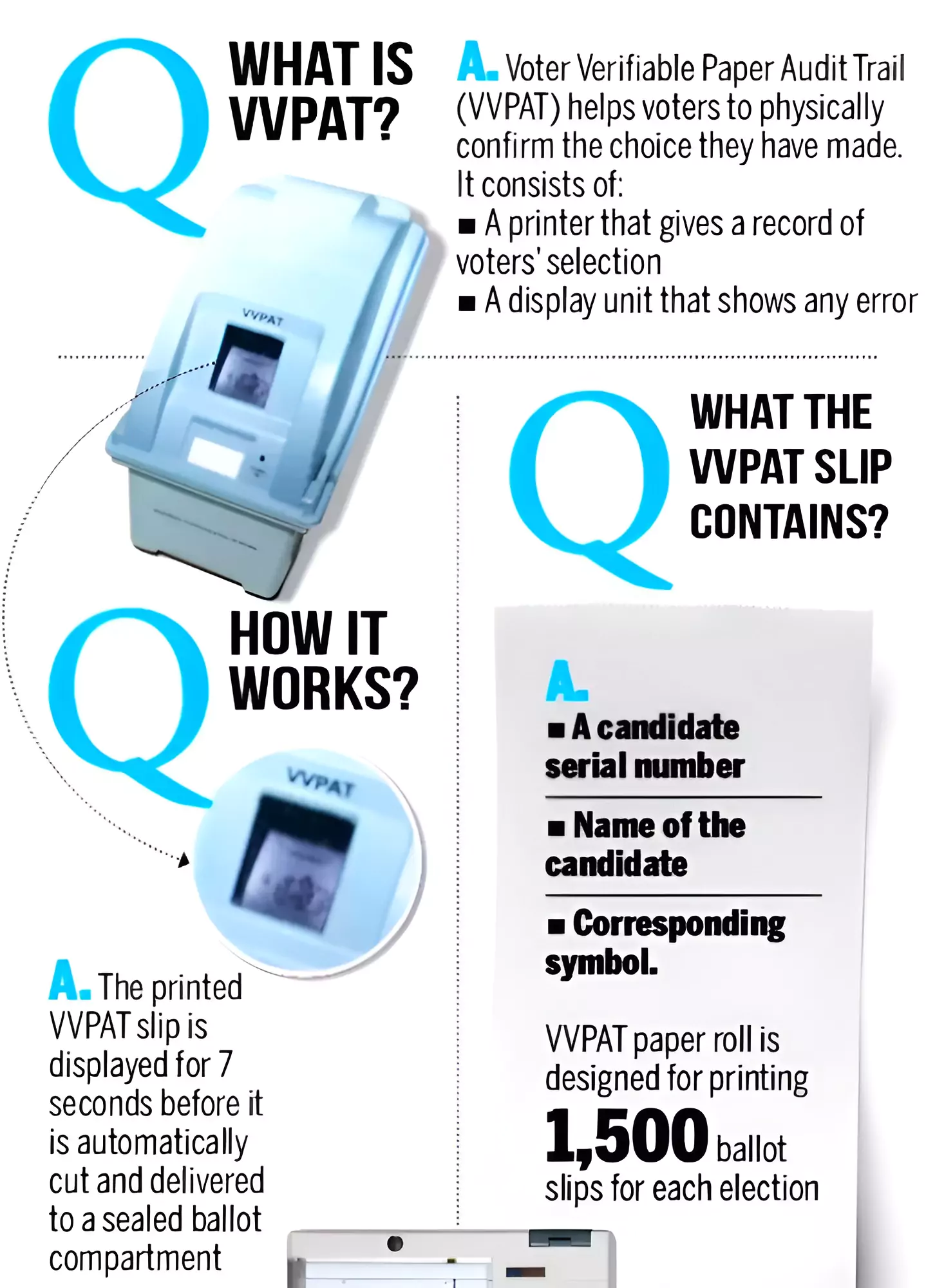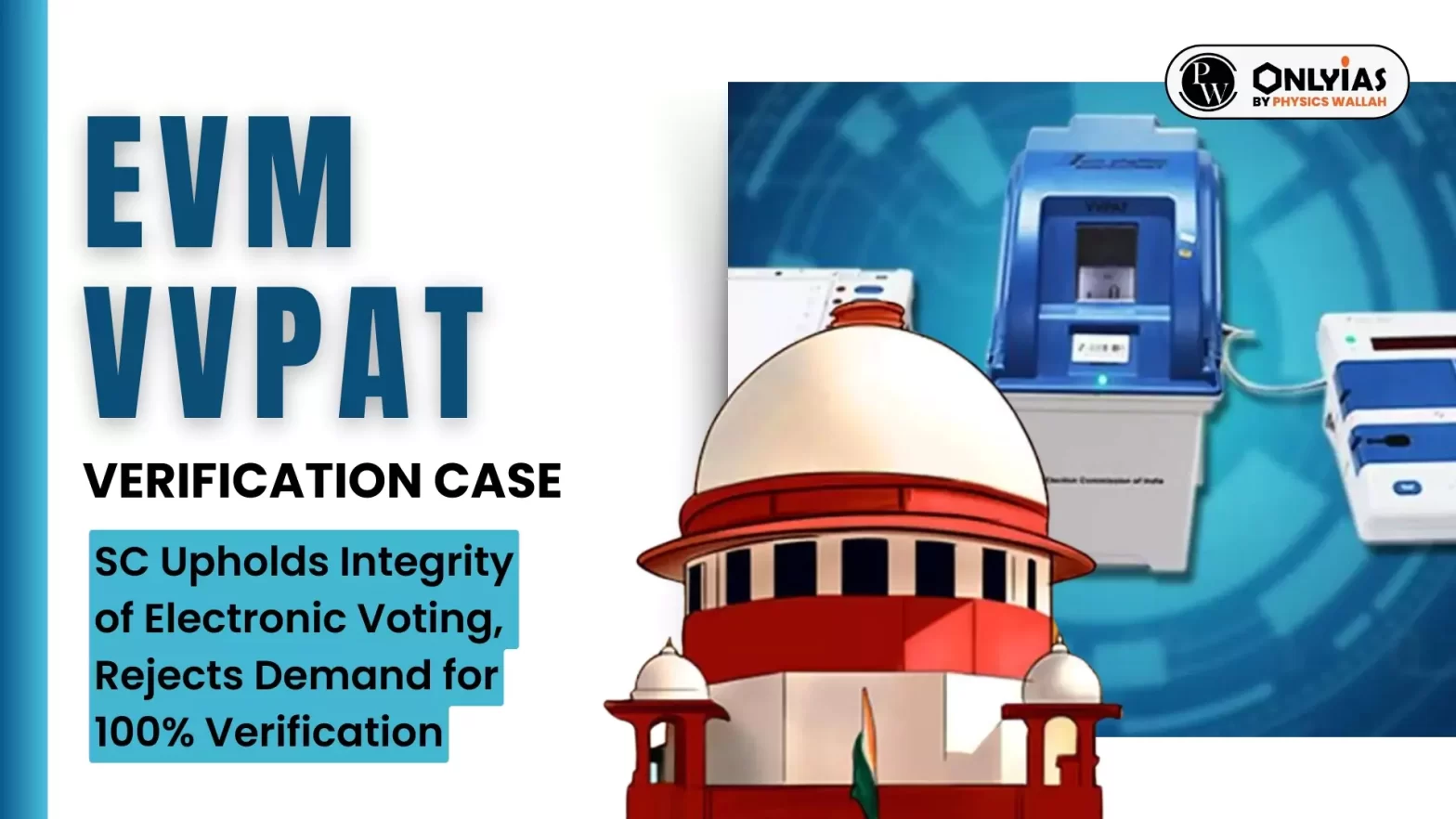Context
Recently, the Supreme Court upheld the electronic voting machine (EVM) system of polling and refused a plea to revive paper ballots.
Background of EVM VVPAT Verification Case
- Filing of Petitions: The NGO Association for Democratic Reforms (ADR), one of the petitioners, had sought to reverse the poll panel’s 2017 decision to replace the transparent glass on Voter Verifiable Paper Audit Trail (VVPAT) machines with an opaque glass through which a voter can see the slip only when the light is on for seven seconds.
- The petitioners have also sought the court’s direction to:
- Revert to the old system of ballot papers,
- The printed slip from the VVPAT machine be given to the voter to verify, and put in the ballot box, for counting,
- That there should be 100% counting of the VVPAT slips in addition to electronic counting by the control unit.
Enroll now for UPSC Online Course
Key Takeaways from the Supreme Court Judgment on EVM VVPAT Verification Case

- Rejection to All Petitions:
-
- The SC refused petitioners’ suggestion to hand over paper slips from Voter Verifiable Paper Audit Trail (VVPAT) units to electors to take a close-down look before inserting them into the ballot boxes.
- The Court also refused to intervene against Section 49 MA of the Conduct of Election Rules.
- This section penalises a voter whose complaint of mismatch (of votes cast and votes counted) would attract penal proceedings initiated by poll officials under Section 177 of the Indian Penal Code for submitting false information.
- The Supreme Court also refused to direct the cross-verification of 100% EVMs and VVPATs across the country. Currently, only 5% of EVM-VVPAT counts are randomly verified in any given Assembly constituency.
- Suggestion for an Electronic Machine for Vote Counting:
- The SC suggested the Election Commission of India (ECI) to examine the suggestion for an electronic machine for vote counting the paper slips and whether along with the symbol, there can be a bar code for each party.
- Storage of Symbol Loading Units (SLUs):
- After completing the process of loading symbols into the EVMs, the SLUs must be sealed and stored in secure containers and shall be kept in the storerooms along with the EVMs at least for 45 days after the declaration of results.
- Post-poll Checking:
- The burnt memory semicontroller in 5% of the EVMs that is the Control Unit, Ballot Unit and the VVPAT per assembly constituency per parliamentary constituency shall be checked and verified by a team of engineers after the declaration of results.
- The actual cost to be borne by the candidate making the request. Expenses to be refunded in case the EVMs are found to be tampered with.
About Association for Democratic Reforms (ADR):
- A Civil Society Group: ADR is a civil society group that focuses on electoral reforms was established in 1999 by a group of professors from the Indian Institute of Management, Ahmedabad.
- Various Interventions: Since its inception, the group has been part of several interventions in the Court that have led to key changes in the electoral laws.
- Led Voters to know the background of Candidates: One of its first cases filed in 1999 was a plea seeking disclosure of a candidate’s criminal background, educational qualification and assets before the election.
- Inclusion of NOTA (None of the Above) option in the EVM: ADR was also one of the petitioners in the SC’s 2013 landmark judgement that led to the inclusion of NOTA option in the EVM.
- Challenge to Electoral Bonds Scheme: In its last major intervention, ADR was one of the lead petitioners to challenge the electoral bonds scheme that was struck down by the Supreme Court in February 2024.
|
- On Voters Right: There is the fundamental right of voters to ensure their vote is accurately recorded and counted, however it cannot be equated with the right to 100% counting of VVPAT slips, or a right to physical access to the VVPAT slips.
- These are two separate aspects – the former is the right itself and the latter is a plea to protect or how to secure the right.
- The Court said that voters’ rights can be safeguarded through other measures.
- Examples:
 VVPATs were introduced after the judgment in Subramanian Swamy v. Election Commission of India case.
VVPATs were introduced after the judgment in Subramanian Swamy v. Election Commission of India case.- The counting of VVPAT slips of 5% EVMs per assembly constituency or assembly segment in a parliamentary constituency was started after directions of the top Court in N. Chandrababu Naidu v. Union of India case.
Superiority of EVMs Over Ballot Paper System
- Elimination of Booth Capturing: EVMs have effectively eliminated booth capturing by restricting the rate of vote casting to 4 votes per minute.
- Hence, prolonging the time needed and thus check insertion of bogus votes.
- Elimination of Invalid Poles: EVMs have eliminated invalid votes, which were a major issue with paper ballots and had often led disputes during the counting process.
- Administrative Convenience: EVMs reduce paper usage and alleviate logistical challenges. They provide administrative convenience by expediting the counting process and minimizing errors.
- So far, there were 41,629 instances of random verification till date. Over four crore VVPAT paper slips had been matched till date. There was not a single instance of mismatch.
- Eco-Friendly: Considering the size of our electorate which is close to one billion, the use of EVMs is eco-friendly as it reduces the consumption of paper.
- Checks to Ensure Integrity of the EVMs and Voting Process:
- Maintenance of Secrecy: Every elector is permitted to vote in secrecy in the voting compartment of the polling station.
- Transparency: The elector is entitled to view through a transparent window the printed VVPAT paper slip.
- Counting is done in the presence of the polling agents/candidates by pressing the ‘RESULT’ button on the control unit.
- Confirmation: Even after entering details in Form 17A and having put signature or thumb impression thereon, if an elector doesn’t vote, the presiding officer is required to make a remark in Form 17A and take the signature or thumb impression of the elector against such remark.
- Periodic Check: The Presiding Officer is periodically required to check the total number of votes cast as recorded in the control unit with the data as recorded in Form 17A.
- Random Check for Accountability: The VVPAT slips of five polling stations per assembly constituency/assembly segment of the parliamentary constituency are randomly selected and counted and then tallied with the electronic results of the control unit.
- Preference to Printed VVPAT Slips: As per ECI guidelines, in case of any mismatch between the total number of votes recorded in the control unit and Form 17C on account of non-clearance of mock poll data or VVPAT slips, the printed VVPAT slips are considered.
- Test by Technical Experts Committee: The EVMs have been subjected to test by technical experts committee from time to time.
Enroll now for UPSC Online Classes
About Electronic Voting Machine (EVM)

- A Portable Instrument: An EVM Machine is a portable instrument for the purpose of conducting elections to the parliament, legislature and local bodies like panchayats and municipalities.
- Manufacturer: Bharat Electronics Ltd. (BEL), Bangalore, a Defence Ministry PSU, was elected along with ECIL to manufacture the EVM Machine.
- Comprises: An EVM Machine has three units – a ballot unit, a control unit for the officer-in-charge to ensure a voter is able to vote only once, and a voter-verifiable-paper-audit-trail (VVPAT) unit, which produces a paper slip that is visible to the voter via a transparent screen for about seven seconds before it gets stored in a sealed drop box.
- Controlled by: The control unit of the EVM is kept with the Presiding Officer and the balloting unit is kept within the voting compartment for electors to cast their votes.
- Legal Sanction: Section 61A was included in the Representation of the People Act 1951, empowering the ECI.
- Representation of People’s Act, 1951 (RPA): It governs the conduct of elections in India. It provides the grounds for disqualifying a person from contesting elections or holding the position of a people’s representative.
- Evolution:
- Trial-Run: The EVM Machine was introduced on a trial basis in 1982 in the Assembly constituency of Paravur in Kerala.
- Nationwide Deployment: They were deployed in all booths during the Assembly elections of Tamil Nadu, Kerala, Puducherry and West Bengal in 2001.
- In the 2004 general elections to the Lok Sabha, EVMs were used in all 543 constituencies.
- The 2019 elections had EVMs backed with 100% VVPAT in all constituencies.
- Ruling by Supreme Court: The SC in various judgments has upheld the validity of using EVMs in elections.
- In Subramanian Swamy versus Election Commission of India (2013), the Supreme Court ruled that a paper trail is an indispensable requirement for free and fair elections.
About Voter Verifiable Paper Audit Trail (VVPAT)

- An Independent System: It is an independent system that consists of two parts, namely, a VVPAT Printer and VVPAT Status Display Unit (VSDU) attached to the Electronic Voting Machines (EVMs), that allow the voters to verify that their votes are cast as intended.
- When a vote is cast, a slip is printed containing the serial number, name, and symbol of the candidate and remains exposed through a transparent window for 7 seconds.
- Came into Use: It was first used in the Noksen constituency in Nagaland in 2013 and used at an all India level in the 2019 Lok Sabha Elections.
- Accessed by: VVPAT machines can be accessed by polling officers only.
About Ballot Paper System
- A Traditional Method: It is the traditional mode of voting and widely used in manual or hand-counted voting systems.
- Manual Marking: Voters physically mark their choices on the paper ballot, typically by filling in circles or boxes next to the names of candidates or options.
- Collection & Counting: Once voters have marked their preferences, they deposit their completed ballots into designated ballot boxes.
- Subsequently, election officials manually count the ballots to determine the election outcome.
- Transparent Process: The visibility of the entire process, from marking the ballot to counting the votes, ensures transparency and instills confidence in the fairness of the electoral exercise.
|
Problems Associated with EVMs and VVPATs Machines
- Potential Vulnerabilities: EVMS are susceptible to hacking as it is an electronic device.
- The ECI has clarified that it is a standalone device like a calculator with no connectivity to any external device and hence free from any kind of external hack.
- Limitations of Current Sample Size: The sample size for matching of the EVM count with VVPAT slips at present is five per assembly constituency/segment.
- This is not based on any scientific criteria and may fail to detect defective EVMs during counting.
- Identification of Booth-wise Polling Behaviour: The present process also allows for booth-wise polling behaviour to be identified by various parties that can result in profiling and intimidation.
- Lack of Accessibility: EVMs pose challenges for certain segments of the population, such as elderly voters or those with disabilities.
- High Cost: The initial investment in procuring and maintaining these machines are high.
- For conducting elections, the Commission expects that a total of Rs 9,284.15 crore will be needed for procurement of EVMs and VVPATs.
Suggestions to Make VVPAT More Transparent
- Machine Audit: A machine audit trail of all the commands that are executed is maintained in the system, beyond just the votes recorded in the EVM’s ballot unit and the printed slips in the VVPATs, allowing for an audit to rule out any malicious code.
- Upgrading Existing Machines: This could indeed make the system more robust and be considered as an upgrade to the existing machines.
- The well-functioning VVPAT are required to alleviate concerns of EVM tampering. The EC should take proactive steps to remedy the concerns with VVPAT.
- Increase in Recounting Samples: An increase in the recount sample to make it more statistically significant, by making the selected number of Assemblies specific to each State/Union Territory based on the size of the province.
- Increase the recount sample in seats where the margin of victory is narrow (say, less than 1% of the overall votes).
- Random Allocation: There is a need for random allocation of EVMs to booths before polls.
- Mock Polls: Conduct of a mock poll to display the correctness of EVMs and VVPAT before commencement of the actual poll.
- Scientific Approach to EVM-VVPAT Matching: 100% match of EVM count with VVPAT slips would be unscientific and cumbersome.
- The sample for matching of EVM count and VVPAT slips should be decided in a scientific manner by dividing each State into large regions as suggested by experts.
- Enhancing Confidence in Counting Process: In case of even a single error, the VVPAT slips should be counted fully for the concerned region and form the basis for results.
- This would instill a statistically significant confidence in the counting process.
- Introducing Totaliser Machines for Enhanced Voter Privacy and Security: In order to provide a degree of cover for voters at the booth level, ‘totaliser’ machines can be introduced that would aggregate votes in 15-20 EVMs before revealing the candidate-wise count.
Enroll now for UPSC Online Course
Conclusion
In the Indian context, keeping in view the vast size of the Indian electorate of nearly 97 crore, the number of candidates who contest the elections, the number of polling booths where voting is held, and the problems faced with ballot papers, there is a need for improvements in the EVMs or even a better system that people would look forward to in the ensuing years. The “voices and choices” of the electorate should be fortified through open dialogue, transparency and trust.
Also Read: Ensuring Transparency And Autonomy In The Election
![]() 27 Apr 2024
27 Apr 2024


 VVPATs were introduced after the judgment in Subramanian Swamy v. Election Commission of India case.
VVPATs were introduced after the judgment in Subramanian Swamy v. Election Commission of India case.